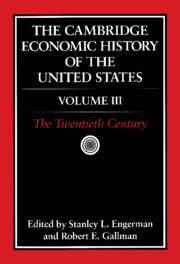Book contents
- Frontmatter
- 1 American Macroeconomic Growth in the Era of Knowledge-Based Progress: The Long-Run Perspective
- 2 Structural Changes: Regional and Urban
- 3 Twentieth-Century Canadian Economic History
- 4 The Twentieth-Century Record of Inequality and Poverty in the United States
- 5 The Great Depression
- 6 War and the American Economy in the Twentieth Century
- 7 U.S. Foreign Trade and Trade Policy in the Twentieth Century
- 8 U.S. Foreign Financial Relations in the Twentieth Century
- 9 Twentieth-Century American Population Growth
- 10 Labor Markets in the Twentieth Century
- 11 Labor Law
- 12 The Transformation of Northern Agriculture, 1910–1990
- 13 Banking and Finance in the Twentieth Century
- 14 Twentieth-Century Technological Change
- 15 The U.S. Corporate Economy in the Twentieth Century
- 16 Government Regulation of Business
- 17 The Public Sector
- Bibliographic Essays
- Index
- References
15 - The U.S. Corporate Economy in the Twentieth Century
Published online by Cambridge University Press: 28 March 2008
- Frontmatter
- 1 American Macroeconomic Growth in the Era of Knowledge-Based Progress: The Long-Run Perspective
- 2 Structural Changes: Regional and Urban
- 3 Twentieth-Century Canadian Economic History
- 4 The Twentieth-Century Record of Inequality and Poverty in the United States
- 5 The Great Depression
- 6 War and the American Economy in the Twentieth Century
- 7 U.S. Foreign Trade and Trade Policy in the Twentieth Century
- 8 U.S. Foreign Financial Relations in the Twentieth Century
- 9 Twentieth-Century American Population Growth
- 10 Labor Markets in the Twentieth Century
- 11 Labor Law
- 12 The Transformation of Northern Agriculture, 1910–1990
- 13 Banking and Finance in the Twentieth Century
- 14 Twentieth-Century Technological Change
- 15 The U.S. Corporate Economy in the Twentieth Century
- 16 Government Regulation of Business
- 17 The Public Sector
- Bibliographic Essays
- Index
- References
Summary
During the past century America’s business system has experienced three dramatic transformations. The first, which climaxed in the last years of the nineteenth and early years of the twentieth centuries and is usually labeled “The Great Merger Movement,” featured a shift to the corporate form of organization and the development of a high degree of concentration in most sectors of the industrial economy. A second, less drastic, wave of change took place in the 1940s and 1950s, when the multidivisional, decentralized firm operating in worldwide markets became the norm for America’s leading enterprises. We are currently experiencing the third and most formidable of these three transformations, as leading U.S. companies – many of them now in the service sector – reorganize and develop appropriate strategies for an international economy characterized by intense competition and seemingly unending pressures to innovate.
All three of these transitions have been successful, and the U.S. corporate economy has, on balance, succeeded in providing society with the goods, services, jobs, and economic opportunities that the American people wanted. The key to that success has been the ability of corporate enterprise to adapt to new conditions in its external environment and to reshape its personnel, organizations, and operations so as to remain innovative over the long term.
The single most important factor accounting for the ability to adapt and innovate has been the manner in which successful U.S. companies have blended corporate resources with professional expertise. This combination has taken place in cultural and institutional settings that have fostered risk-taking and creative change.
- Type
- Chapter
- Information
- The Cambridge Economic History of the United States , pp. 927 - 968Publisher: Cambridge University PressPrint publication year: 2000
References
- 4
- Cited by



